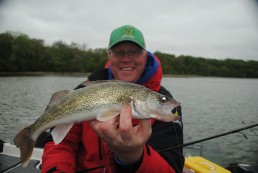Catching Early-Season Fish
SHARE THIS POST
Fish are very willing biters early in the year, so Bob Jensen recommends small, slow-moving baits to be most productive.
There’s still snow on the ground and ice on the lake, but the predicted rain and thunder will knock both down very quickly. Every day, we’re getting closer to another season of open-water fishing. Early-season fishing can be really good, but sometimes it’s not as good as we’d like. Here are some things you can do to get early-season fish to bite at least a little bit even when they don’t want to.
Usually, the primary cause of fish being hard to catch early in the year is weather. A slight drop in water temperature can have a significant effect on the activity of the fish. However, we go fishing when we get the chance, so if you get in a situation early in the year when the fish are reluctant to bite, you should slow your lure presentation and downsize your lures. A jig tipped with a minnow about 3 inches long is good for walleyes, and a jig tipped with a smaller minnow can be good for crappies. Fish, in the spring, typically like smaller baits.
Because we’re moving our baits slower this time of year, we want a lower-visibility line. Fish can get a better look at slower-moving baits, so if you think that line can spook the fish, go with a line that’s harder for the fish to see. Try 4-pound test for panfish, 6- or 8-pound test for walleyes.
Wally Marshall, a.k.a. Mr. Crappie, says that, “when the redbirds are whistling, the crappies start biting.” The redbirds that he refers to are cardinals, and he’s right. There are signs in nature that indicate natural activities, and cardinals and crappies seem to be on the same page. When the cardinals are happy and singing, the crappies are happy and eating.
A small jig under a slip-bobber is a great way to catch early-season panfish. Set the bobber so the bait will be a little bit above the fish. Many expert panfish anglers like jigs that are mostly black because there are lots of insect hatches in the spring, and most of those insects are black. These anglers subscribe to the “match the hatch” theory. Other crappie anglers, including Mr. Crappie, take color in a different direction. Marshall likes a Mr. Crappie Sausage Head in the Refrigerator White color in the spring. There aren’t very many bugs in the water that look like a Refrigerator White Sausage Head jig, and some anglers think that that appeals to the fish. Kind of a “don’t match the hatch” theory.
Are you enjoying this post?
You can be among the first to get the latest info on where to go, what to use and how to use it!
If you can, be willing to move to different bodies of water. In spring, some lakes warm faster than others. A shallow lake with stained water will warm faster than a deep lake with clear water. The fish in the warmer water will usually be more willing to bite early in the season, and we want to be around biting fish.
Last thing. If you just want action, be willing to fish for the species that is most likely to provide action. Some species will be more willing to bite than others at this time of year. If the walleyes have just finished spawning, they often won’t be hungry. But the pike that spawned earlier, or the crappies and bass that will spawn later, will often be more willing to eat your bait. It’s a lot more fun to catch a few pike than not catch any walleyes.
Keep these ideas in mind on your early-season, open-water fishing trips and you’ll increase your odds for fishing success.
Get better results from the time you spend fishing. Use information from the pros found in every issue of MidWest Outdoors, available by subscribing on our website.
MWO
SHARE THIS POST
You may also like...
Nothing found.
Did you enjoy this post?
You can be among the first to get the latest info on where to go, what to use and how to use it!
Bob Jensen
To see the latest episodes of “Fishing the Midwest” television, new fishing-related tips and articles from the past, visit fishingthemidwest.com. Follow them on Facebook @fishingthemidwest for fishing information and entertainment.
